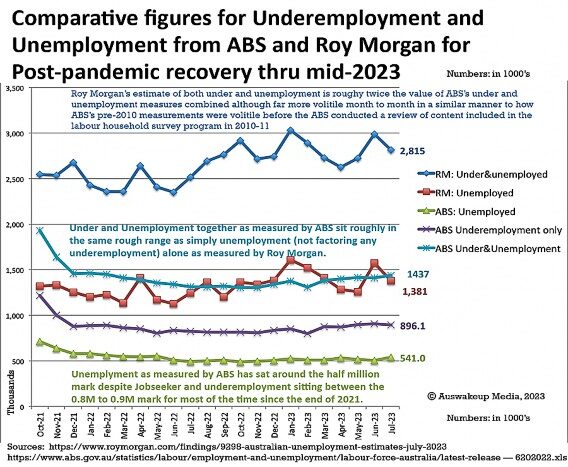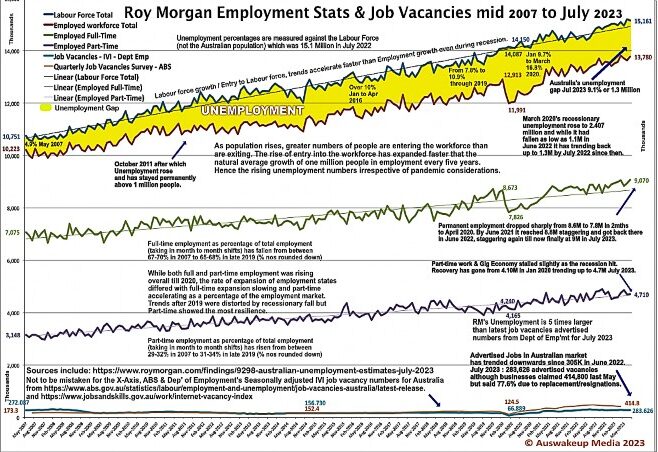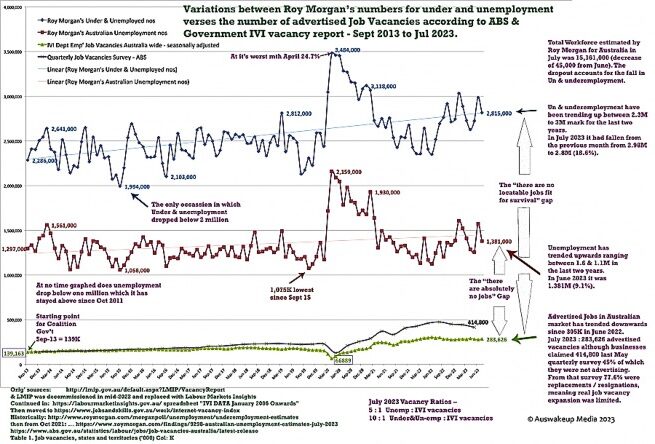Choosing unemployment: what of job seekers? – part 2
John Haly
This is a continuation of part1 of the article by John Haly, which appeared in the previous issue of ERA Review.
To understand claims made within the Australian Bureau of Statistics (ABS) unemployment data, it is necessary to understand the methods used by the ABS. According to Gareth Hutchens, the ABS estimates primarily serve the interests of employers rather than the general public or government policy (Hutchens, 2021). The ABS methodology deals with a distinct subset of the overall unemployed population, by providing information about the number of people who are readily accessible for immediate labour exploitation. This statistic is achieved by systematically excluding individuals who may potentially be unavailable.
These include:
- Excluding people who have worked for as little as one hour in a month — not just a week, as many have alleged (Keen, 2014),
- Excluding people who work in a family company or busk on the streets, even if completely without compensation (Australian Bureau of Statistics, 2022),
- Using the 12/16 rule to exclude any foreign workers who may not yet have expended the financial resources they brought into the country (Australian Bureau of Statistics, 2014),
- Excluding people who participate in the increasing gig economy regardless of whether they receive any money because they have a “job attachment” (Australian Bureau of Statistics, 2021).
- Excluding people who are demonstrably unable to accept immediate work on demand (Australian Bureau of Statistics, 2018),
- Excluding people who are registered in government-sponsored jobless work programs, such as the PaTH program, as they are deemed to be “employed” (Haly, 2019), and
- Excluding people who are found to be unable to offer active evidence of seeking employment (Hutchens, 2021).
In summary, an individual must be in a desperate, active search for employment opportunities, have no prospects for obtaining any form of income, be not enrolled in a government employment program such as PaTH, refrain from assisting a family business or busking on the streets, and have no obstacles that would impede their immediate exploitability by a potential employer. One may ask how well the ABS description informs the public and policymakers about what constitutes an equitable assessment of actual domestic unemployment. It is the contention of this research that the ABS description fulfills the former referenced capitalist’s objective but is not relevant for policy or public awareness.
Based on data provided by the ABS, as depicted in Figure 1*, approximately half a million people are unemployed, a figure that has remained roughly consistent over the past year. Those individuals who possess a gig “job attachment” (as collected and defined by the ABS) but do not receive work opportunities or remuneration are not classified as unemployed (note the dotted purple line in Figure 1*).
If such people were included it would be necessary to add 65,000 to 90,000 more people to the unemployment numbers covering the past half year. This addition would result in a substantial rise in the unemployment rate, which amounts approximately to the Reserve Bank’s NAIRU threshold of 4.5% (Emerson, 2023). The absence of sufficient justifications would have then rendered any potential increase in interest rates unwarranted, as the desired employment threshold had not been breached at that time. Therefore, the inclusion of these unpaid job attachments would not condone the rationale behind the RBA’s interest rate increase for mitigating inflation in our economy. And even without these, Prof John Quiggin’s disassembling of the grounds for the NAIRU in the “The Conversation” demonstrates that 2023’s economy fails to support the RBA’s idea of a NAIRU (Quiggin, 2023).
The RBA’s monetary policy framework does not use a precise unemployment count (See Figure 1). If unemployment was measured using the hard count of JobSeeker, the resulting figure would indicate an unemployment rate in excess of 6%. Despite the prevalent capitalist and political tendency to extol the virtues of private enterprise, the government and media refuse to acknowledge Roy Morgan’s estimate of unemployment. As Prof Steve Keen mentioned in his early 2014 article in “The Australian”, this is an oversight (Keen, 2014).
For Roy Morgan, Australian unemployment stands at 1.3 million and has remained consistently high over the past two years, never dropping below 1.1 million (see Figure 2).

Disregarding this significant figure would be an oversight, even in passing. Despite their extensive collection of statistical data on unemployment over several decades, the prevailing conservative viewpoint within the establishment remains predominantly opposed to giving consideration to the research reported by private organisations like Roy Morgan. Even though the ABS unemployment number aggregated with the number of their own zero hours gig economy workers surpassed the Job Seeker figures for a number of months during the Covid pandemic, Roy Morgan’s estimate which would be the only larger viable estimate has been disregarded. It may be argued that the ABS capitulation to ILO standards for categorisation of joblessness, as depicted, does not adequately capture the gestalt manifestations of real domestic unemployment. (O’Donnell, 2019. Pg 97, 114 & 142).
Mention of the Roy Morgan research is conspicuously absent from the discourse of policymakers and members of the RBA. Acknowledging Roy Morgan’s significance would imply that interest rates should have never deviated from the 0.1% threshold. The government would then face significant challenges in attempting to rationalise the high unemployment rates (Figure 3) to the general public. Therefore, it is improbable that policymakers in either the government or the board of the Reserve Bank will ever consider Roy Morgan’s statistics due to an ideological bias that precludes logical reasoning or critical evidentiary analysis.

The federal government tends to mention underemployment only sporadically. Following the pandemic’s relative abatement, representations of underemployment and unemployment rates have remained at around half of the levels stated by Roy Morgan’s “disreputable” private enterprise models. These aggregated rates fell from their peak during the pandemic until the end of 2021, when they began a staggered, fluctuating increase (see Figures 2 & 4). The magnitude of this composite representation is usually in the double-digit percentage range.
However, it is important to note that the usual RBA unemployment graphs do not display a combination of these numbers, as demonstrated in figures 2 and 4 (Chambers, Chapman, and Rogerson, 2021). The seasonally adjusted statistics for underemployment and unemployment in July 2023, according to the smaller ABS figures, were 929.9K and 541K, respectively, for a total of 1.4709 million people. This represents more than 10% of the ABS labour force, however the ABS has always reported the statistical numbers separately.
In contrast, Roy Morgan’s aggregate estimates of underemployment and unemployment were roughly twice as large as the ABS figures, totalling 2.815 million (See Figure 2). Based on the labour force evaluation conducted by Roy Morgan, this figure corresponds to 18.6% (or 19.3% if based on the ABS smaller labour force size estimates). As indicated by the ABS, the seasonally adjusted size of the labour force exhibits a notable disparity with a reduction of 593,300 people in July, compared to the measurement reported by Roy Morgan, (see Figures 1 and 3). Nevertheless, according to Roy Morgan, approximately 45,000 people were reportedly withdrawn from the labour force. The ABS reported a seasonally adjusted rise in the labour force of 21,000, narrowing the gap between their respective labour force estimates by 66,000. However, there is still a huge disparity of over half a million between the two estimations.

The graph in Figure 1 where ABS plus unpaid job attachees (purple dashed line) climb above Jobseeker numbers (highlighted in green), suggests that Roy Morgan’s estimations are the most probabilistically plausible. This segment illustrates that from August to October 2021, the ABS unemployment estimates and the zero-hours numbers surpassed the JobSeeker numbers. Further elaboration on this topic can be found in the article “Josh’s Jobless Jargon,” published in April 2022 (Haly, 2022a).
John Haly is a qualified multimedia and graphic designer, as well as video and film producer and freelance journalist He also possesses a B.Bus degree, and currently is studying for the degree of Master of Economic Sustainability.
Both parts of this article are published at http://auswakeup.net.au/choosing-unemployment-part-2-what-of-job-vacancies/
References
* Figure 1 appeared in Part 1 of the article (ERA Review, v16, n1, Nov-Dec 2023, page 25)
Australian Bureau of Statistics (2014, Feb 13). Feature Article Migrant Data in ABS Labour Statistics (Feature Article). Retrieved from the www.abs.gov.au website: https://www.abs.gov.au/AUSSTATS/[email protected]/featurearticlesbyCatalogue/B556F5EE53D86809CA2575E70019CC74
Australian Bureau of Statistics (2018). Main Features Not in the Labour Force. Retrieved from the abs.gov.au website: https://www.abs.gov.au/ausstats/[email protected]/Lookup/by%20 Subject/6102.0.55.001~Feb%202018~Main%20Features~Not%20in%20the%20Labour%20 Force~8
Australian Bureau of Statistics (2021, Nov 11). Insights into job attachment during the pandemic. Retrieved from www.abs.gov.au website: https://www.abs.gov.au/articles/insights-job-attachment-during-pandemic
Australian Bureau of Statistics (2022). Explanatory Notes. Retrieved from abs.gov.au website: https://www.abs.gov.au/AUSSTATS/[email protected]/Lookup/6211.0Explanatory%20Notes1Jun%202006?OpenDocument
Chambers, M., Chapman, B., & Rogerson, E. (2021). Underemployment in the Australian Labour Market June Quarter 2021, Bulletin (June). Retrieved from https://www.rba.gov.au/publications/bulletin/2021/jun/underemployment-in-the-australian-labourmarket.html
Emerson, C. (2023, August 7). The dubious statistic steering the Reserve Bank. Retrieved from Australian Financial Review website: https://www.afr.com/policy/economy/thedubiousstatistic-steering-the-reserve-bank-20230806-p5du8w
Haly, J. (2019, Jan 9). PaTH to Misery. Retrieved September 26, 2023, from The AIM Network website: https://theaimn.com/path-to-misery/
Haly, J. (2022a, Apr 1). Josh’s jobless jargon. Retrieved from Independent Australia website: https://independentaustralia.net/politics/politics-display/joshs-jobless-jargon
Hutchens, G. (2021, Oct 16). Why are millions of unemployed people excluded from our monthly “unemployment” data?. ABC News. Retrieved from https://www.abc.net.au/news/2021-10-17/why-are-millions-of-unemployed-people-excluded-from-the-data/100543854
Keen, S. (2014, Aug 11). The truth about Australia’s unemployment rate “shocker.” Retrieved from The Australian website: https://www.theaustralian.com.au/news/thetruthabout-australias-unemployment-rate-shocker/news-story/deb6f41ef2df6cc72730e9a5c2a7617e
O’Donnell, A. (2019). Inventing unemployment : regulating joblessness in twentieth-century Australia. Oxford ; New York: Hart.
Quiggin, J. (2023, Sep 19). Living in the 70s: why Australia’s dominant model of unemployment and inflation no longer works. Retrieved from The Conversation website: https://theconversation.com/living-in-the-70s-why-australias-dominant-modelofunemployment-and-inflation-no-longer-works-211487



























